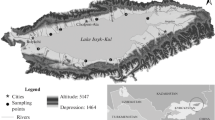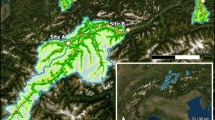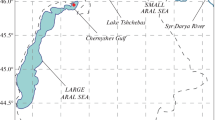Abstract
Saline emissions can elevate water densities and have the potential to alter stratification and mixing dynamics in lakes. In the light of rising anthropogenic salinization of temperate freshwater lakes, it is highly relevant to understand how saline emissions, as well as the rehabilitation from salt pollution might affect lake circulation patterns. In this study, we present the impact of industrial pollution with chloride salts on the deep Alpine lake Traunsee in Austria from 1930 to 2005 and the observed limnological changes during the recovery from salinization in the following 12 years. We assembled and analysed a unique dataset of monthly sampling profiles covering chloride, conductivity, temperature and dissolved oxygen over a 87-year period. We quantified the impact of saline emissions on the lake’s total chloride content, water densities, stability indices and deepwater oxygen concentrations. Time-series of water density profiles and stability indices revealed a significant impact of salinization on seasonal stratification and mixing. Higher dilution and shallower release of saline wastes and the short water retention in Traunsee helped to prevent a long-lasting density stratification. Nevertheless, two periods of salt-induced meromixis occurred in the lake. The first was caused directly by the disposal of saline wastes into the deepwater in the 1930s and 1940s, whereas the second was induced by the recovery from salinization in recent years. The naturally faster wash-out of salts from shallower water layers reinforced the density gradient and impeded vertical water circulation after salt pollution ceased. The rehabilitation from salinization had a stronger effect on stratification intensity and deepwater oxygen concentration than the continuous salt pollution over the last century.









Similar content being viewed by others
References
Adrian R, O’Reilly CM, Zagarese H, Baines SB, Hessen DO, Keller W et al (2009) Lakes as sentinels of climate change. Limnol Oceanogr 54:2283–2297
Ambrosetti W, Barbanti L, Sala N (2003) Residence time and physical processes in lakes. J Limnol 62:1–15
Anderson GC (1958) Seasonal characteristics of two saline lakes in Washington. Limnol Oceanogr 3:51–68
Auer I, Böhm R, Jurkovic A, Lipa W, Orlik A, Potzmann R et al (2007) HISTALP—historical instrumental climatological surface time series of the greater Alpine region 1760–2003. Int J Climatol 27:17–46
Blöschl G, Nester T, Komma J, Parajka J, Perdigão RAP (2013) The June 2013 flood in the Upper Danube Basin, and comparisons with the 2002, 1954 and 1899 floods. Hydrol Earth Syst Sci 17:5197–5212
Boehrer B, von Rohden C, Schultze M (2017) Physical features of meromictic lakes: stratification and circulation. In: Gulati RD, Zadereev ES, Degermendzhi AG (eds) Ecology of meromictic lakes, vol 228. Springer, Berlin
CCME (2011) Canadian water quality guidelines for the protection of aquatic life: chloride. Canadian Council of Ministers of the Environment, Winnipeg
Cole JJ, Pace ML (1998) Hydrologic variability of small, Northern Michigan Lakes measured by the addition of tracers. Ecosystems 1:310–320
Doerr SM, Effler SW, Whitehead KA, Auer MT, Perkins M, Heidtke TM (1994) Chloride model for polluted Onondaga Lake. Water Res 28:849–861
Dugan HA, Bartlett SL, Burke SM, Doubek JP, Krivak-Tetley FE, Skaff NK et al (2017a) Salting our freshwater lakes. Proc Natl Acad Sci 114:4453–4458
Dugan HA, Summers JC, Skaff NK, Krivak-Tetley FE, Doubek JP, Burke SM et al (2017b) Long-term chloride concentrations in North American and European freshwater lakes. Sci Data 4:170101. https://doi.org/10.1038/sdata.2017.101
Effler SW, Driscroll CT (1986) A chloride budget for Onondaga Lake, New York, U.S.A. Water Air Soil Pollut 27:29–44
Effler SW, Matthews DA (2003) Impacts of soda ash facility on Onondaga lake and the Seneca River, NY. Lake Reserv Manag 19:285–306
Effler SW, Owens EM (1996) Density stratification in Onondaga lake: 1968–1994. Lake Reserv Manag 12:25–33
Effler SW, Auer MT, Johnson N A (1989) Modeling Cl concentraion in Cayuga Lake, USA. Water Air Soil Pollut 44:347–362
EPA (1988) Ambient water quality criteria for chloride. United States Environmental Protection Agency, Washington, DC
Evans M, Frick C (2001) The effects of road salts on aquatic ecosystems. National Water Research Institute, Environment Canada, Ottawa, Canada Contribution Series No. 02-308, August 2001
Ficker H, Gassner H, Achleitner D, Schabetsberger R (2011) Ectogenic meromixis of Lake Hallstättersee, Austria induced by waste water intrusions from salt mining. Water Air Soil Pollut 218:109–120
Ficker H, Luger M, Gassner H (2017) From dimictic to monomictic: empirical evidence of thermal regime transitions in three deep Alpine lakes in Austria induced by climate change. Freshw Biol 62:1335–1345
Griebler C, Sonntag B, Mindl B, Posch T, Klammer S, Psenner R (2002) Assessment of the ecological integrity of Traunsee (Austria) via analysis of sediments and benthic microbial communities. Water Air Soil Pollut Focus 2:33–62
Hakala A (2004) Meromixis as a part of lake evolution – observations and a revised classification of true meromictic lakes in Finland. Boreal Environ Res 9(1):37–53
Imboden DM, Wüest A (1995) Mixing mechanisms in lakes. In: Lerman A, Imboden DM, Gat JR (eds) Physics and chemistry of lakes. Springer, Berlin
ISO 7888:1985, Water quality—determination of electrical conductivity. International Organization for Standardization, Geneva, pp 1–6
Jagsch A, Gassner H, Dokulil MT (2002) Long-term changes in environmental variables of Traunsee, an oligotrophic Austrian lake impacted by the salt industry, and two reference sites, Hallstättersee and Attersee. Water Air Soil Pollut Focus 2:9–20
Jones FE, Harris GL (1992) ITS-90 density of water formulation for volumetric standards calibration. J Res Natl Inst Stand Technol 97:335–340
Kaushal SS, Groffman PM, Likens GE, Belt KT, Stack WP, Kelly VR et al (2005) Increases salinization of fresh water in the northeastern United States. Proc Natl Acad Sci 102:13517–13520
Löffler H (1983) Changes of the benthic fauna of the profundal zone of Traunsee (Austria) due to salt mining activities. Hydrobiologia 103:135–139
Miller LG, Jellison R, Oremland RS, Culbertson CW (1993) Meromixis in hypersaline Mono Lake, California. 3. Biogeochemical response to stratification and overturn. Limnol Oceanogr 38:1040–1051
Moreira S, Schultze M, Rahn K, Boehrer B (2016) A practical approach to lake water density from electrical conductivity and temperature. Hydrol Earth Syst Sci 20:2975–2986
Müller B, Gächter R (2011) Increasing chloride concentrations in Lake Constance: characterization of sources and estimation of loads. Aquat Sci 74:101–112
North RP, Livingstone DM (2013) Comparison of linear and cubic spline methods of interpolating lake water column profiles. Limnol Oceanogr 11:213–224
North RP, North RL, Livingstone DM, Köster O, Kipfer R (2014) Long-term changes in hypoxia and soluble reactive phosphorus in the hypolimnion of a large temperate lake: consequences of a climate regime shift. Glob Change Biol 20:811–823
O’Reilly CM, Sharma S, Gray DK, Hampton SE, Read JS, Rowley RJ et al (2015) Rapid and highly variable warming of lake surface waters around the globe. Geophys Res Lett 42:10773–10781
Pechlaner R, Sossau C (1982) Die Ergebnisse der 5-jährigen Studie, Limnologische Untersuchung Traunsee-Traun. Zusammenfassender Bericht Nr 13, Oberösterreichische Landesregierung, Linz
Pilotti M, Sinoncelli S, Valerio G (2014) A simple approach to the evaluation of the actual water renewal time of natural stratified lakes. Water Resour Res 50:2830–2849
Read JS, Hamilton DP, Jonses ID, Muraoka K, Winslow L, Kroiss R et al (2011) Derivation of lake mixing and stratification indices from high-resolution lake buoy data. Environ Model Softw 26:1325–1336
Rimmer A, Aoata Y, Kumagai M, Eckert W (2005) Chemical stratification in thermally stratified lakes: a chloride mass balance model. Limnol Oceanogr 50:147–157
Rogora M, Mosello R, Kamburska L, Salmaso N, Cerasino L, Leoni B et al (2015) Recent trends in chloride and sodium concentrations in the deep subalpine lakes (Northern Italy). Environ Sci Pollut Res 22:19013–19026
Sahoo GB, Forrest AL, Schladow SG, Reuter JE, Coats R, Dettinger M (2015) Climate change impacts on lake thermal dynamics and ecosystem vulnerabilities. Limnol Oceanogr 61:496–507
Sanderson B, Perry K, Pedersen T (1986) Vertical diffusion in meromictic Powell lake, British Columbia. J Geophys Res 91:7647–7655
Schwefel R, Gaudard A, Wüest A, Bouffard D (2016) Effects of climate change on deepwater oxygen and winter mixing in a deep lake (Lake Geneva): comparing observational findings and modeling. Water Resour Res 52:8811–8826
Sonntag B, Posch T, Klammer S, Griebler C, Psenner R (2002) Protozooplankton in the deep oligotrophic Traunsee (Austria) influenced by discharges of soda and salt industries. Water Air Soil Pollut Focus 2:211–226
Sossau C (1982) Schichtungs- und Strömungsverhältnisse, Chlorid und Sauerstoff im Traunsee. Limnologische Untersuchung Traunsee-Traun. Bericht Nr 9, Oberösterreichische Landesregierung, Linz
Sossau C, Pechlaner R (1988) The regained, but hidden holomixis of the Austrian Lake Traunsee. Verh Internat Ver Limnol 23:74–79
Steinhauser G (2008) Cleaner production in the Solvay Process: general strategies and recent developments. J Clean Prod 16:833–841
Thies H, Nickus U, Arnold C, Psennner R (2002) A hydrological tracer experiment with LiCl in a high mountain lake. Hydrol Process 16:2329–2337
Varekamp JC (2002) Lake contamination models for evolution towards steady state. Papers from Bolsena conference, residence time in lakes: science, management, education. J Limnol 62(Suppl. 1):67–72
Wanzenböck J, Gassner H, Lahnsteiner B, Hassan Y, Hauseder G, Doblander C et al (2002) Ecological integrity assessment of lakes using fish communities: an example from Traunsee exposed to intensive fishing and to effluents from the soda industry. Water Air Soil Pollut Focus 2:227–248
Winkler LW (1889) Die Löslichkeit des Sauerstoffs in Wasser. Berichte der deutschen chemischen Gesellschaft 22:1764–1774
Wüest A, Sommer T, Schmid M, Carpenter JR (2012) Diffusive-type of double diffusion in lakes—a review. In: Environmental fluid mechanics: memorial volume in honour of Prof. Gerhar H. Jirka, IAHR monograph. CRC Press, Boca Raton, pp 271–284
Zadereev ES, Gulati RD, Camacho A (2017) Biological and ecological features, trophic structure and energy flow in meromictic lakes. In: Gulati RD, Zadereev ES, Degermendzhi AG (eds) Ecology of meromictic lakes, vol 228. Springer, Berlin
Acknowledgements
We thank Solvay Österreich GmbH, Salinen Austria AG and the Landesregierung Oberösterreich for extensive long-term monitoring of Traunsee and data acquisition.
Author information
Authors and Affiliations
Corresponding author
Appendix
Appendix
Temporal and spatial dimensions of sampling profiles
The temporal and spatial resolution of sampling increased steadily over the first ten years of the monitoring program conducted from 1930 to 2016. The long-term records of water temperature, conductivity and chloride concentration predominantly comprise monthly vertical sampling profiles in at least 17 depth layers between surface and lake bottom from the 1950s onwards.
Linear regression of chloride vs. conductivity measurements
See Fig. 14.
Development of daily stability indices of Traunsee between 1930 and 2016
See Fig. 15.
Rights and permissions
About this article
Cite this article
Ficker, H., Luger, M., Pamminger-Lahnsteiner, B. et al. Diluting a salty soup: Impact of long-lasting salt pollution on a deep Alpine lake (Traunsee, Austria) and the downside of recent recovery from salinization. Aquat Sci 81, 7 (2019). https://doi.org/10.1007/s00027-018-0602-3
Received:
Accepted:
Published:
DOI: https://doi.org/10.1007/s00027-018-0602-3










